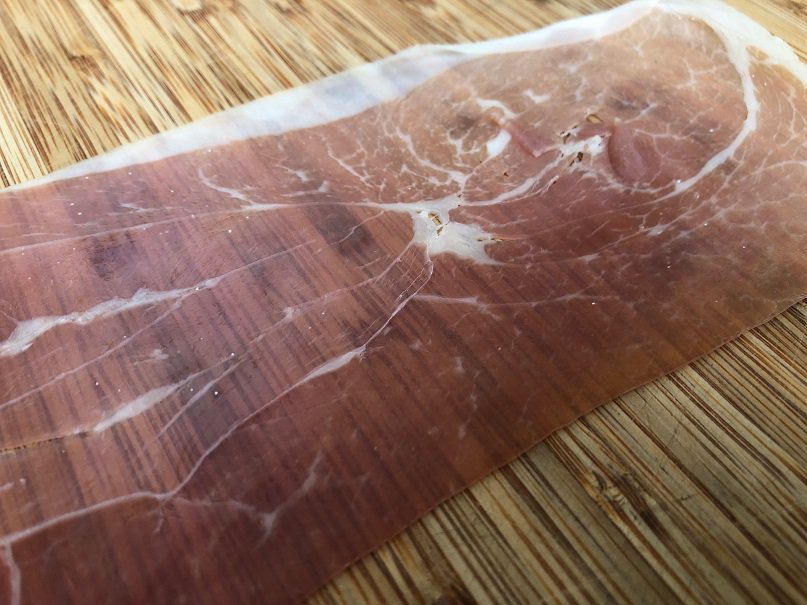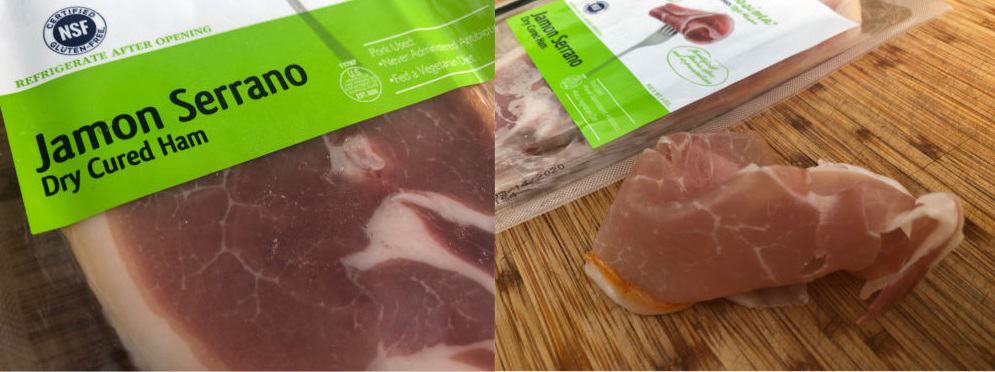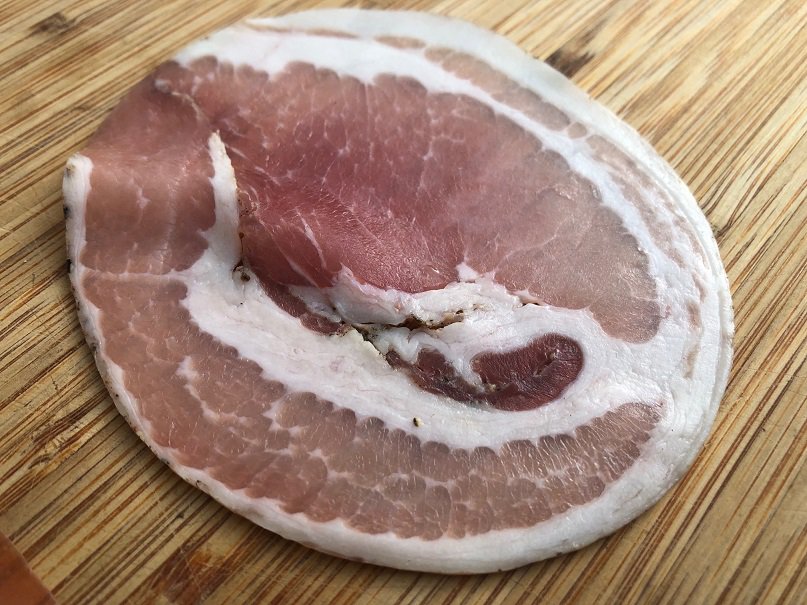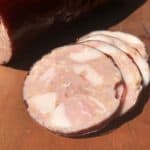Pancetta and Prosciutto are two classic Italian methods of preparing pork. While both products are wonderful there are quite a few differences between them and it causes a lot of confusion for some people.
Let’s take a look at what these cuts are, the primary differences between them and a few nice ways of serving. By the way, in the picture below the meat on the left is prosciutto and the meat on the right is pancetta.

What Is Prosciutto?
Prosciutto, at its most basic level, is simply the hind leg of a pig that has been salted and dry cured for several months. The length of time the ham is dry cured varies considerably. Most of the prosciutto you will find in US supermarkets has been aged for about seven months while the truly premium varieties are aged for up to three years.

This is considered an Italian style product and there are several regional variations of prosciutto that have have Protected Designation of Origin (PDO) status. The most famous of the PDO products is Prosciutto di Parma followed by Prosciutto di San Daniele.
Here is a great look at how Prosciutto di Parma is actually produced.
As the video shows, the hams are trimmed to shape and then pressed to remove any residual blood. The hams are coated in sea salt, refrigerated for a period of time and then salted again. After the second salting the hams are hung to dry for about 80 days in an environment with controlled temperature and humidity. When the first stage of aging is complete the exposed meat is coated with a mixture of lard, salt and pepper and then rehung to dry for at least one year.
One of the things that makes regional products like Prosciutto di Parma special is the hogs that provide the hams. The hogs must be raised in the specific geographical region and, while their food is supplemented, they forage on the local acorns, etc. Hogs from the Parma region often are fed the excess whey from the production of the other famous local delicacy Parmesan Reggiano.
Can You Eat Prosciutto Raw?
Yes, you absolutely can eat prosciutto raw! It is safe to eat this raw meat because the salt and drying process have created a very low moisture environment that prevents bacterial growth.
Raw prosciutto, typically sliced paper thin, is salty with a powerful ham flavor and a pleasant chew. While it can be enjoyed by itself it is FREAKING FANTASTIC when wrapped around slices of melon or apples. There are countless ways of serving this cut. You can use it to make a true Italian panini, cut it into strips and use as the secret ingredient in a pasta salad.
Some people are freaked out about the thought of eating raw meat and for those folks there are two options.
First off, you can cook the meat, either by heating in a skillet or simmering in a pasta sauce. Crunchy stips of cooked prosciutto have a more intense flavor than the raw product and are great salad toppings!
Your second option is to buy pre-cooked prosciutto. The traditional dry cured product that is served “raw” is technically termed “Prosciutto Crudo”. There is another product that is dry cured and then cooked that is called “Prosciutto Cotto”. The cotto product can be hard to find but is a great option if eating raw meat is not your thing 🙂
Prosciutto Alternatives
There are several great alternatives to prosciutto that all have their passionate advocates.
If you want to stay with Italian style cured meats then you can always try a product known as “Speck”. Speck is almost identical to prosciutto except is has been cold smoked in addition to being dry cured. Personally, I like Speck a little more than Prosciutto because of the extra layer of smokey flavor. (Not to be confused with German Speck which is a form of bacon.)

Another Italian classic cured meat that is similar to prosciutto is “Culatello”. While prosciutto is made from the whole hind leg of a hog, culatello is made by dry curing and aging a single muscle taken from the ham.
If you want to venture away from Italian cured meats then you can treat yourself to some Spanish specialities. A classic Spanish dry cured ham that is very similar to prosciutto is Jamon Serrano. Honestly, most people would not be able to tell the difference between the two products

There are several other famous Spanish dry cured hams with Jamon Iberico being the most famous.
What is Pancetta?
Pancetta is made from pork belly that has been seasoned with herbs and curing salts and then tied into a circular roll. After tying off, the pancetta is typically dried in a cool environment for two to three weeks. Pancetta is essentially the Italian version of bacon.

Here is a beautiful video showing how pancetta is made.
Can You Eat Pancetta Raw?
No, you do not want to raw eat pancetta. Pancetta is classified as a “streaky bacon” and must be cooked to be safely consumed.
Whether or not you should eat pancetta raw is often a topic of debate on many food forums. One of the common arguments that says it is okay to eat this raw is that you will often find pancetta in the deli case along with all of the other ready to eat meats. Another argument is that, for almost every package of pancetta I have ever seen, there are no instructions for consumption. The package never says, “Cook Thoroughly” nor does it say “Ready To Eat“. Some people take this lack of guidance as evidence that it is okay to eat pancetta raw.
The reality is that pancetta does not get dried cured long enough to create the low moisture environment that inhibits bacterial growth.
To be clear, there are many people who do eat raw pancetta but it is not a practice that I recommend.
Pancetta Alternatives
If your recipe calls for pancetta and you can’t find any at your local store then standard American style bacon is a perfectly acceptable substitute.
If you want to try something that is even better that pancetta then treat yourself to some guanciale. Guanciale is bacon that is made with the jowl meat from a hog. While it might be hard finding authentic guanciale at your store go ahead and look for “Jowl Bacon” as this is much more common. The true beauty of guanciale comes from the texture of the fat and meat and not necessarily the seasonings, so jowl bacon works just as well in my book.


